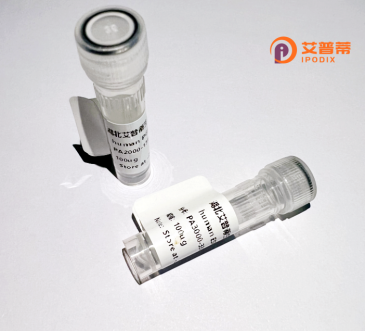
| 纯度 | >90%SDS-PAGE. |
| 种属 | Human |
| 靶点 | SENP5 |
| Uniprot No | Q96HI0 |
| 内毒素 | < 0.01EU/μg |
| 表达宿主 | E.coli |
| 表达区间 | 1-755 aa |
| 活性数据 | MKKQRKILWR KGIHLAFSEK WNTGFGGFKK FYFHQHLCIL KAKLGRPVTW NRQLRHFQGR KKALQIQKTW IKDEPLCAKT KFNVATQNVS TLSSKVKRKD AKHFISSSKT LLRLQAEKLL SSAKNSDHEY CREKNLLKAV TDFPSNSALG QANGHRPRTD PQPSDFPMKF NGESQSPGES GTIVVTLNNH KRKGFCYGCC QGPEHHRNGG PLIPKKFQLN QHRRIKLSPL MMYEKLSMIR FRYRILRSQH FRTKSKVCKL RKAQRSWVQK VTGDHQETRR ENGEGGSCSP FPSPEPKDPS CRHQPYFPDM DSSAVVKGTN SHVPDCHTKG SSFLGKELSL DEAFPDQQNG SATNAWDQSS CSSPKWECTE LIHDIPLPEH RSNTMFISET EREIMTLGQE NQTSSVSDDR VKLSVSGADT SVSSVDGPVS QKAVQNENSY QMEEDGSLKQ SILSSELLDH PYCKSPLEAP LVCSGLKLEN QVGGGKNSQK ASPVDDEQLS VCLSGFLDEV MKKYGSLVPL SEKEVLGRLK DVFNEDFSNR KPFINREITN YRARHQKCNF RIFYNKHMLD MDDLATLDGQ NWLNDQVINM YGELIMDAVP DKVHFFNSFF HRQLVTKGYN GVKRWTKKVD LFKKSLLLIP IHLEVHWSLI TVTLSNRIIS FYDSQGIHFK FCVENIRKYL LTEAREKNRP EFLQGWQTAV TKCIPQQKND SDCGVFVLQY CKCLALEQPF QFSQEDMPRV RKRIYKELCE CRLMD |
| 分子量 | 86.6 kDa |
| 蛋白标签 | His tag N-Terminus |
| 缓冲液 | PBS, pH7.4, containing 0.01% SKL, 1mM DTT, 5% Trehalose and Proclin300. |
| 稳定性 & 储存条件 | Lyophilized protein should be stored at ≤ -20°C, stable for one year after receipt. Reconstituted protein solution can be stored at 2-8°C for 2-7 days. Aliquots of reconstituted samples are stable at ≤ -20°C for 3 months. |
| 复溶 | Always centrifuge tubes before opening.Do not mix by vortex or pipetting. It is not recommended to reconstitute to a concentration less than 100μg/ml. Dissolve the lyophilized protein in distilled water. Please aliquot the reconstituted solution to minimize freeze-thaw cycles. |
以下为3篇关于重组人SENP5蛋白的示例参考文献(文献信息为模拟概括,建议通过学术数据库核对原文):
1. **"Biochemical characterization of SENP5: a SUMO-specific protease with redox-sensitive activity"**
- **作者**: Kolli et al.
- **摘要**: 研究在大肠杆菌中重组表达人SENP5.发现其特异性催化SUMO前体蛋白的成熟化,并揭示了其酶活性受细胞内氧化还原状态调控的机制。
2. **"SENP5 regulates mitochondrial fission and chromosome segregation during mitosis"**
- **作者**: Shen et al.
- **摘要**: 通过体外纯化的重组SENP5蛋白,结合细胞实验证明其通过去SUMO化修饰Drp1蛋白,调控线粒体分裂和染色体正确分离,缺失会导致有丝分裂异常。
3. **"Structural basis of SENP5 recognition by SUMO2/3"**
- **作者**: Huang et al.
- **摘要**: 解析了重组人SENP5催化结构域的晶体结构,阐明了其与SUMO2/3的相互作用界面,为开发靶向SENP5的小分子抑制剂提供了结构基础。
*提示:实际文献可通过PubMed或Web of Science以关键词“SENP5 recombinant”或“SENP5 SUMO protease”检索获取。部分研究可能涉及癌症、神经退行性疾病中的功能探索。*
Recombinant human SENP5 (Sentrin/SUMO-specific protease 5) is a member of the SUMO-specific protease family, which plays a critical role in modulating SUMO (Small Ubiquitin-like Modifier) post-translational modifications. SENP5 regulates SUMOylation dynamics by processing SUMO precursors, deconjugating SUMO from target proteins, and recycling poly-SUMO chains, thereby maintaining cellular SUMO homeostasis. It exhibits substrate specificity toward SUMO-2/3 isoforms and is primarily localized in the nucleolus and mitotic chromosomes, implicating its involvement in ribosome biogenesis, genome stability, and mitotic progression. Dysregulation of SENP5 has been linked to pathologies including cancer, neurodegenerative disorders, and cardiovascular diseases, making it an emerging therapeutic target.
The recombinant SENP5 protein is typically produced in *E. coli* or eukaryotic expression systems, purified via affinity chromatography (e.g., His-tag), and utilized for *in vitro* studies. Its structure includes a conserved C-terminal catalytic domain responsible for protease activity and an N-terminal regulatory region that influences substrate binding and subcellular localization. Research applications include enzymatic activity assays, protein interaction studies, drug screening, and structural analyses to dissect its role in SUMO-mediated pathways. Recent studies also highlight its involvement in mitochondrial dynamics, autophagy, and cellular stress responses. However, mechanistic details of its regulation, substrate specificity, and crosstalk with other post-translational modifications remain incompletely understood, necessitating further exploration.
×